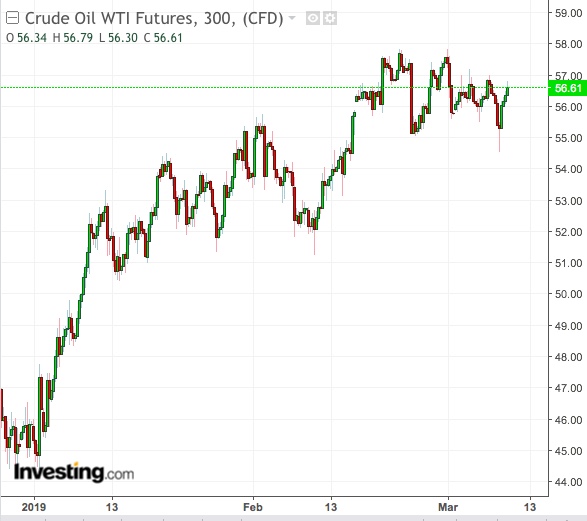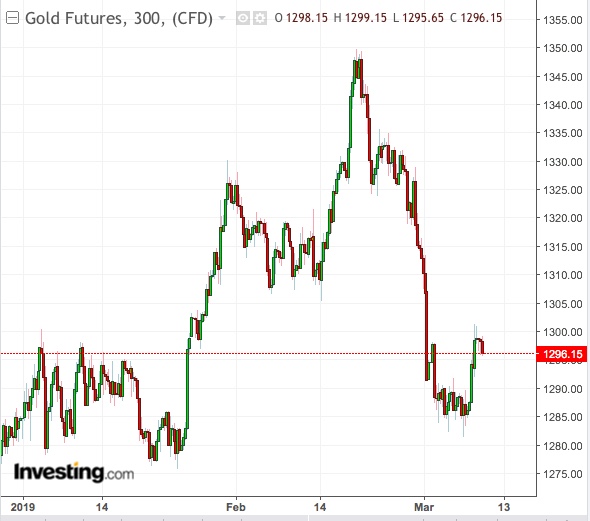Can U.S. crude production continue making record highs while oil companies cut back on drilling? It’s something worth pondering after the U.S. oil rig count hit 10-month lows last week, without a corresponding slack in production.

With OPEC relentlessly cutting its own output, investors in oil have been watching whether declining rig numbers will translate into lower output on the U.S. side too. The lack of a correlation thus far—ostensibly due to better drilling efficiencies—has been daunting to some market bulls hoping to see West Texas Intermediate crude hit $60 per barrel and cut its discount to Brent, the better performing global oil benchmark, which trades at about $10 higher.
Investors in gold, meanwhile, are facing their own conundrum: was Friday’s high above $1,300 an ounce a flash-in-the-pan or the start of a breakout from the range-bound declines of the past week? Will demand for the safe-haven metal spike hereon, as February’s dismal U.S. jobs numbers add to slowdown fears in Europe and China?
Litany of Data For Commodity Investors
The pathway to successful commodities investing this week could also require the correct interpretation of upcoming U.S. data like retail sales figures for January, February inflation reading and latest the durable goods orders, all of which takes on added significance after recent stats showed a retreat in consumer and business activity.
Other items on watch will be a key Brexit vote that could point to where Britain is headed on its messy divorce with the EU, and the latest Chinese industrial production data that might give an insight on GDP growth amid Beijing’s unresolved tariff war with Washington.
Rig Efficiencies Continue To Mystify
Economic worries aside, the oil market has been trying to pin down the answer to something that could pretty much decide the cost of a barrel of WTI over the next few years: how much better can drilling efficiencies get?
Richard Rostad, analyst at Oil & Gas 360, noted that, as of January, rigs in the major U.S. shale oil basins were yielding nearly three times as much production as five years back, although efficiencies had declined since the start of this year.
But even with the U.S. rig count falling to 834 last week, the lowest since May 2018, domestic crude production rewrote this month's previous peaks to reach 12.1 million barrels per day.
Reuters columnist John Kemp constantly reminds the market that the weekly rig count issued by oil services firm Baker Hughes is a lagged data that publishes results some six weeks after they are collected. Notwithstanding that, one thing’s certain: the hydraulic fracking technology that powered shale to the biggest oil glut in history is continuing to evolve beyond market expectations, and could frustrate OPEC’s long-term efforts to determine global oil prices.
Veteran energy analyst Dominick Chirichella, who has tracked the oil market for about 40 years, didn’t miss the phenomenon in his weekly note, remarking:
“The U.S. upstream sector has 48% fewer drilling rigs than in October 2014, but is producing nearly 36% more oil.”
U.S. Oil Production, Exports Not Letting Up
The U.S. Energy Information Administration, meanwhile, is forecasting an even higher supply of 13 million bpd by the end of next year. Many analysts believe that peak will be reached well before the EIA target, especially with oil majors Exxon Mobil (NYSE:XOM) and Chevron (NYSE:CVX) planning additional production of close to 1 million bpd each from top shale basin Permian.
Two other things will be needed though for shale to continue growing the way it is: export demand, and enough pipeline capacity to carry oil out of the Permian and other basins like the Bakken, after years of transportation bottlenecks.
Both of those elements appear to be coming through as well.
U.S. crude exports have surpassed a record 3.6 million bpd. Permian pipeline capacity is expected triple to 9 million bpd by the end of 2021. Bakken, with 1.4 million bpd capacity as of November, could have a takeaway of 1.8 million by the end of next year.
New York-based Energy Intelligence wrote in its weekly newsletter:
“The U.S. shale oil patch has once again defied expectations around midstream infrastructure constraints—this time, just weeks into a new year that was supposed to see bottlenecks dampen output growth through late 2019.”
New Gold Impetus Vs U.S. Dollar

Meanwhile, in gold, Friday’s brief surge to $1,300 highs caught disbelievers flat-footed, prompting some to rethink entering new short positions.
U.S. jobs numbers for February that came in almost 90% below expectations, and renewed growth worries in Europe and China could give gold's rebound more steam this week.
Fawad Razaqzada, a London-based analyst for forex.com, said:
"We favor looking for bearish setups on the dollar against gold and silver, given the renewed weaknesses in government bond yields".
The Dollar Index, which measures the greenback against a basket of six currencies, was up just 0.1% at 97.365 in early Asian trade on Monday, well off three-month highs of 97.67 hit on Thursday.
